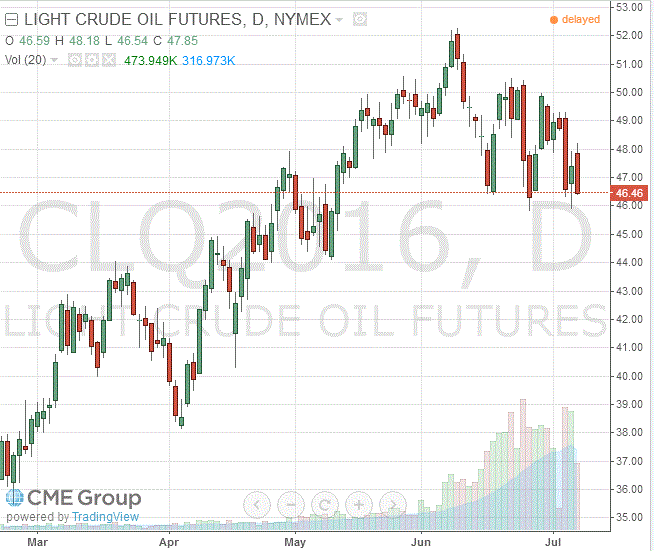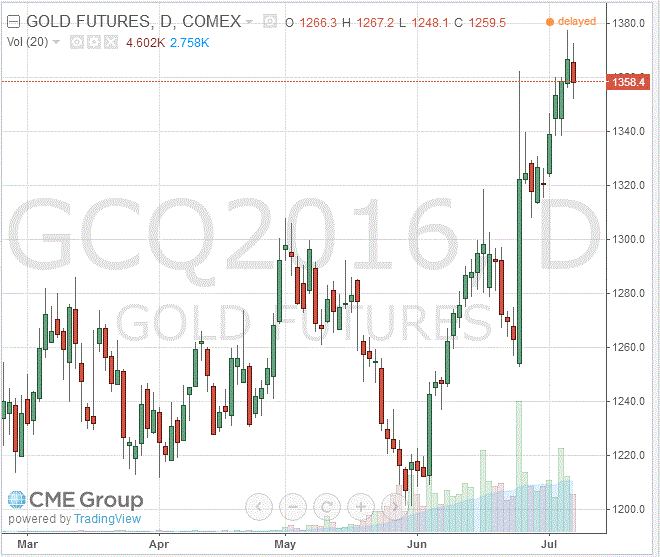Noticias del mercado
-
17:51
The price of oil dropped about 3%
Oil prices are down significantly, under the pressure of a report on US petroleum reserves, much weaker than yesterday's data on the API.
US Department of Energy reported that in the week of June 25 - July 1, oil stocks fell by 2.2 million barrels to 524.4 million barrels. This is close to the highest level for more than 80 years. Forecasts indicated a decrease of 2.5 million barrels. Oil reserves in Cushing terminal fell by 82,000 barrels to 64.1 million barrels. It was predicted a decline of 400,000 barrels. Gasoline inventories fell by 122,000 barrels to 238.9 million barrels. Analysts had expected stocks to fall 300,000 barrels. Distillate stocks fell 1.6 million barrels to 148.9 million barrels as nalysts had forecast an increase of 100,000 barrels. The utilization of refining capacity fell by 0.5% to 92.5% and oil production fell to 8.428 million barrels per day versus 8.622 million barrels the previous week, the maximum rates since September 2013.
Yesterday the American Petroleum Institute reported that for the week to July 3, crude oil inventories fell to 6.736 million barrels, a record change from June 2015. Gasoline inventories also fell 3.6 million barrels. Distillate stocks fell 2.3 million barrels, while crude oil stocks in the Cushing terminal rose by 80 thousand barrels.
Continued high demand for oil in China and India gave little suport to prices. Experts disagree on when the supply and demand balance will be restored, but more and more analysts are inclined to think that the situation has tightened the supply of oil, and the market could be in deficit within two years.
However, Libyan officials said that export oil terminals, which have been closed since 2014, may reopen in the near future. As a result, the export potential can be restored to 600,000 barrels per day.
The cost of the August futures for WTI fell to 46.46 dollars per barrel.
The price of August futures for Brent fell to 47.62 dollars a barrel on the London Stock Exchange ICE Futures Europe.

-
17:33
Gold price declined
The cost of gold has decreased from the highest level since March 2014, which was due to the strengthening of the dollar against the backdrop of the US employment statistics. However, a further decline in prices constrain concerns about the effects of Brexit.
Financial markets remain highly volatile after results of the referendum provoked a collapse of stocks, bonds reduced the yield to a record low, as well as increased demand for safe-haven assets such as gold and silver. Yesterday the spot price of gold toucked the high of March 2014, but there was no follow through due to rise of stocks and the US dollar.
Mitsubishi analyst Jonathan Butler said while the strong dollar is a "headwind" for gold, there are good opportunities for further rally of the precious metal. "I believe that gold can go up to $ 1381 or even higher than the psychological level of $ 1,400"
One of the reasons for today's strengthening of the US dollar was ADP data, which showed that employment growth in the private sector accelerated in June, and was higher than forecast. According to the report, the number of employees increased by 172K. It was expected that the number of employees to increase by 159 thousand.
Investors are also awaiting the publication of Friday's employment report in the US non-farm sector, which could affect the prospects of US monetary policy. Adverse findings reinforce the view that the Fed has little reason to raise interest rates this year. Until recently, it had been widely expected that the Fed will raise rates at some point this summer. Nevertheless, given Brexit and US data, investors are now skeptical about that.
The cost of the August gold futures on the COMEX fell to $ 1358.4 per ounce.

-
17:13
Crude oil inventories in US declined last week
- Oil: -2.223 (forecast -2.5)
- Gasoline: -122K (350K forecast).
- Distillates: -1574K (500K forecast).
- Cushing: -82K (-400K forecasts).
-
00:33
Commodities. Daily history for Jul 06’2016:
(raw materials / closing price /% change)
Oil 47.89 +0.97%
Gold 1,365.70 -0.10%
-